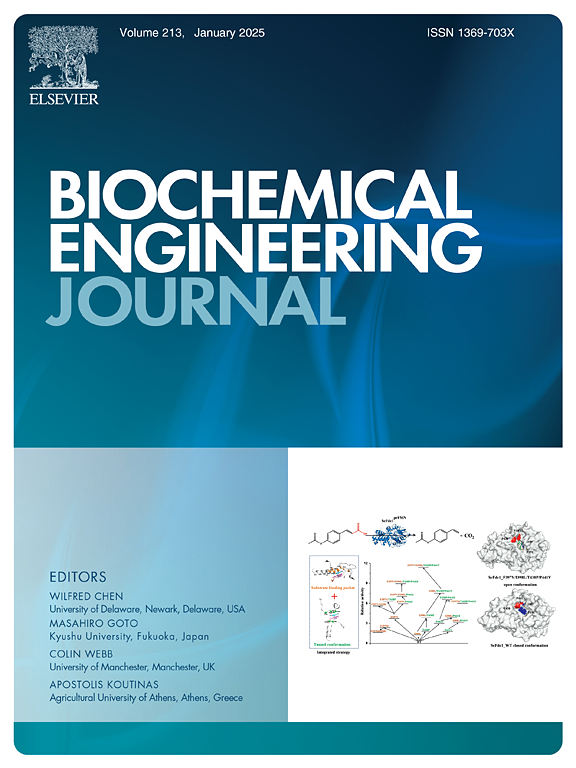番茄红素合成无细胞代谢工程系统的构建与优化
IF 3.7
3区 生物学
Q2 BIOTECHNOLOGY & APPLIED MICROBIOLOGY
引用次数: 0
摘要
本研究设计了一种体外合成番茄红素的无细胞代谢工程系统。首先,对Deinococcus wulumuqiensis R12中的三个关键酶——香叶基香叶基焦磷酸合成酶、植物烯合成酶和植物烯去饱和酶进行了全面的生物信息学分析,以评估它们的系统发育关系和功能域特征。随后,构建了外源表达系统,使这些酶在重组大肠杆菌中可溶过表达。以重组大肠杆菌粗提物和纯化酶为原料,构建并优化了番茄红素的无细胞代谢工程合成体系。通过对两种平台的比较,并对酶浓度、底物浓度、酶比、辅因子、金属离子等关键参数进行优化,24 h后,无细胞体系的番茄红素滴度为14.06 mg/L。最后,利用该合成系统进行了快速酶筛选和体内番茄红素合成验证。该构建策略展示了CFME在基于纯化酶的无细胞体系快速优化、基于细胞粗提物的无细胞体系优化和快速酶筛选方面的三大应用,为类胡萝卜素等复杂化合物合成的多酶途径设计和优化提供了可参考的研究策略和合成平台。本文章由计算机程序翻译,如有差异,请以英文原文为准。
Construction and optimization of a cell-free metabolic engineering system for lycopene synthesis
In this study, a cell-free metabolic engineering system was designed for the synthesis of lycopene in vitro. Initially, comprehensive bioinformatic analysis was performed on three key enzymes from Deinococcus wulumuqiensis R12, geranylgeranyl pyrophosphate synthase, phytoene synthase and phytoene desaturase to assess their phylogenetic relationships and characterize functional domains. Subsequently, heterologous expression systems were constructed to enable soluble overexpression of these enzymes in recombinant Escherichia coli. The cell-free metabolic engineering synthesis system was constructed and optimized, based on the purified enzymes and crude extracts from recombinant Escherichia coli for lycopene synthesis. After comparing the two different platforms and optimizing various key parameters, including enzyme concentration, substrate concentration, enzyme ratio, cofactors, and metal ions, a lycopene titer of 14.06 mg/L was achieved in the cell-free system after 24 h. Finally, the synthetic system was employed to validate a rapid enzyme screen and to validate lycopene synthesis in vivo. This construction strategy demonstrates three major applications of CFME in rapid optimization of cell-free systems based on purified enzymes, the optimization of cell-free systems based on crude cell extracts and the rapid enzyme screening and provides a referable research strategy and synthesis platform for the design and optimization of multienzyme pathways for the synthesis of complex compounds such as carotenoids.
求助全文
通过发布文献求助,成功后即可免费获取论文全文。
去求助
来源期刊

Biochemical Engineering Journal
工程技术-工程:化工
CiteScore
7.10
自引率
5.10%
发文量
380
审稿时长
34 days
期刊介绍:
The Biochemical Engineering Journal aims to promote progress in the crucial chemical engineering aspects of the development of biological processes associated with everything from raw materials preparation to product recovery relevant to industries as diverse as medical/healthcare, industrial biotechnology, and environmental biotechnology.
The Journal welcomes full length original research papers, short communications, and review papers* in the following research fields:
Biocatalysis (enzyme or microbial) and biotransformations, including immobilized biocatalyst preparation and kinetics
Biosensors and Biodevices including biofabrication and novel fuel cell development
Bioseparations including scale-up and protein refolding/renaturation
Environmental Bioengineering including bioconversion, bioremediation, and microbial fuel cells
Bioreactor Systems including characterization, optimization and scale-up
Bioresources and Biorefinery Engineering including biomass conversion, biofuels, bioenergy, and optimization
Industrial Biotechnology including specialty chemicals, platform chemicals and neutraceuticals
Biomaterials and Tissue Engineering including bioartificial organs, cell encapsulation, and controlled release
Cell Culture Engineering (plant, animal or insect cells) including viral vectors, monoclonal antibodies, recombinant proteins, vaccines, and secondary metabolites
Cell Therapies and Stem Cells including pluripotent, mesenchymal and hematopoietic stem cells; immunotherapies; tissue-specific differentiation; and cryopreservation
Metabolic Engineering, Systems and Synthetic Biology including OMICS, bioinformatics, in silico biology, and metabolic flux analysis
Protein Engineering including enzyme engineering and directed evolution.
 求助内容:
求助内容: 应助结果提醒方式:
应助结果提醒方式:


